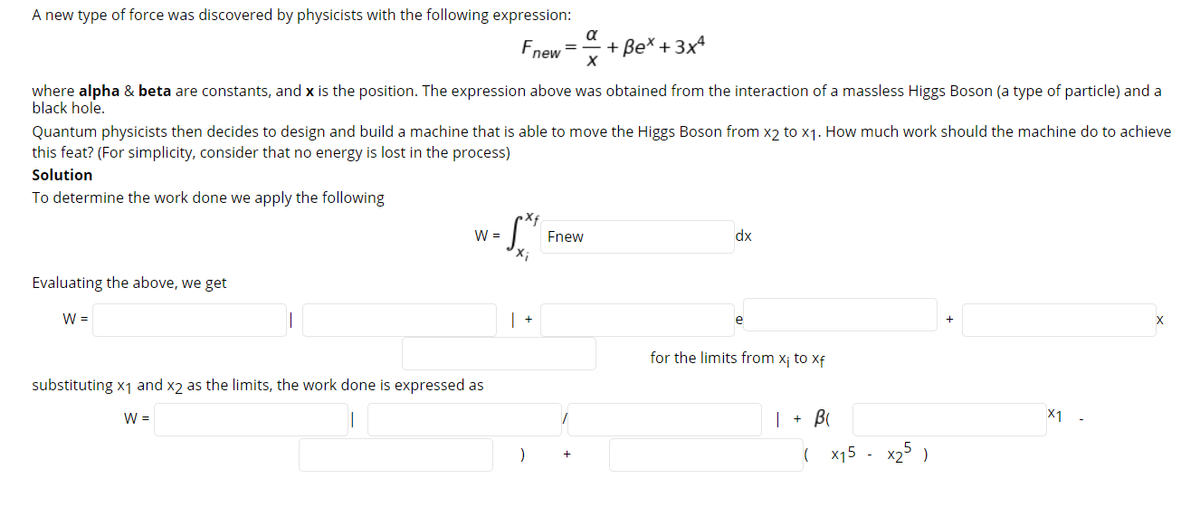A new type of force was discovered by physicists with the following expression: a Fnew = + Be* + 3x4 where alpha & beta are constants, and x is the position. The expression above was obtained from the interaction of a massless Higgs Boson (a type of particle) and a black hole. Quantum physicists then decides to design and build a machine that is able to move the Higgs Boson from x2 to x1. How much work should the machine do to achieve this feat? (For simplicity, consider that no energy is lost in the process) Solution To determine the work done we apply the following W = Fnew dx Evaluating the above, we get W = | + for the limits from x¡ to xf substituting x1 and x2 as the limits, the work done is expressed as W = | + B X1 . ( x15 - x25 )
A new type of force was discovered by physicists with the following expression: a Fnew = + Be* + 3x4 where alpha & beta are constants, and x is the position. The expression above was obtained from the interaction of a massless Higgs Boson (a type of particle) and a black hole. Quantum physicists then decides to design and build a machine that is able to move the Higgs Boson from x2 to x1. How much work should the machine do to achieve this feat? (For simplicity, consider that no energy is lost in the process) Solution To determine the work done we apply the following W = Fnew dx Evaluating the above, we get W = | + for the limits from x¡ to xf substituting x1 and x2 as the limits, the work done is expressed as W = | + B X1 . ( x15 - x25 )
Physics for Scientists and Engineers with Modern Physics
10th Edition
ISBN:9781337553292
Author:Raymond A. Serway, John W. Jewett
Publisher:Raymond A. Serway, John W. Jewett
Chapter44: Particle Physics And Cosmology
Section: Chapter Questions
Problem 12P
Related questions
Question
100%
please provide answers respectively as what the answer boxes ask so I could easily configure what to put in the boxes. There are a total of 13 boxes, I expect 13 boxes to be highlighted. May the answer be in good penmanship or typewritten so I could understand it better, thank you!

Transcribed Image Text:A new type of force was discovered by physicists with the following expression:
a
Fnew
+ Be* + 3x4
where alpha & beta are constants, and x is the position. The expression above was obtained from the interaction of a massless Higgs Boson (a type of particle) and a
black hole.
Quantum physicists then decides to design and build a machine that is able to move the Higgs Boson from x2 to x1. How much work should the machine do to achieve
this feat? (For simplicity, consider that no energy is lost in the process)
Solution
To determine the work done we apply the following
W =
Fnew
dx
x;
Evaluating the above, we get
W =
| +
for the limits from x¡ to Xf
substituting x1 and x2 as the limits, the work done is expressed as
W =
| + B
X1
( x15 - x25 )
Expert Solution
This question has been solved!
Explore an expertly crafted, step-by-step solution for a thorough understanding of key concepts.
This is a popular solution!
Trending now
This is a popular solution!
Step by step
Solved in 2 steps

Knowledge Booster
Learn more about
Need a deep-dive on the concept behind this application? Look no further. Learn more about this topic, physics and related others by exploring similar questions and additional content below.Recommended textbooks for you

Physics for Scientists and Engineers with Modern …
Physics
ISBN:
9781337553292
Author:
Raymond A. Serway, John W. Jewett
Publisher:
Cengage Learning

Principles of Physics: A Calculus-Based Text
Physics
ISBN:
9781133104261
Author:
Raymond A. Serway, John W. Jewett
Publisher:
Cengage Learning

Modern Physics
Physics
ISBN:
9781111794378
Author:
Raymond A. Serway, Clement J. Moses, Curt A. Moyer
Publisher:
Cengage Learning

Physics for Scientists and Engineers with Modern …
Physics
ISBN:
9781337553292
Author:
Raymond A. Serway, John W. Jewett
Publisher:
Cengage Learning

Principles of Physics: A Calculus-Based Text
Physics
ISBN:
9781133104261
Author:
Raymond A. Serway, John W. Jewett
Publisher:
Cengage Learning

Modern Physics
Physics
ISBN:
9781111794378
Author:
Raymond A. Serway, Clement J. Moses, Curt A. Moyer
Publisher:
Cengage Learning

College Physics
Physics
ISBN:
9781938168000
Author:
Paul Peter Urone, Roger Hinrichs
Publisher:
OpenStax College

Classical Dynamics of Particles and Systems
Physics
ISBN:
9780534408961
Author:
Stephen T. Thornton, Jerry B. Marion
Publisher:
Cengage Learning